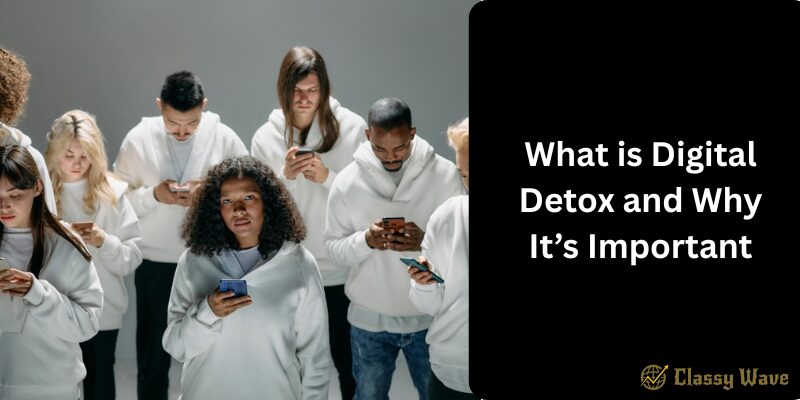What is Digital Detox and Why It’s Important | Classy Wave
In today’s hyper-connected world, most of us wake up to phone notifications and end the day scrolling through social media. Technology has become a major part of our lives — but too much of it can lead to stress, anxiety, and burnout. That’s where the concept of a digital detox comes in.
A digital detox means taking a break from screens — your smartphone, laptop, TV, or social media — to reconnect with yourself, the people around you, and the real world.
What is Digital Detox?
A digital detox is a conscious decision to reduce or completely cut off the use of digital devices for a certain period. The idea isn’t to quit technology forever but to find a healthy balance between online and offline life.
During a digital detox, people often avoid:
- Social media apps
- Emails and work notifications
- Video games
- Streaming platforms and TV
The goal is to refresh your mind, lower digital dependence, and focus on real-life experiences.
Why Do We Need a Digital Detox?
Technology has made life easier, but overuse can negatively affect our mental and physical health. Constant exposure to screens and notifications can make us:
- Feel overwhelmed or anxious
- Lose sleep due to late-night screen time
- Experience eye strain and headaches
- Become less productive
By stepping away from digital devices, we give our brains the rest they need to reset and recharge.
Signs You Need a Digital Detox
Here are some common signs that you might need a break from screens:
- You check your phone immediately after waking up.
- You feel anxious when you’re not online.
- You scroll social media for hours without realizing it.
- You struggle to focus or sleep well.
- You feel disconnected from people around you.
If these sound familiar, it might be time to hit the pause button on technology.
The Benefits of Digital Detox
1. Better Mental Health
Stepping away from screens helps reduce anxiety, stress, and the fear of missing out (FOMO). It also improves mindfulness and emotional balance.
2. Improved Sleep Quality
Blue light from screens disrupts your sleep cycle. A digital detox before bedtime can help you fall asleep faster and wake up feeling more refreshed.
3. Increased Productivity
Without constant notifications, your focus improves, allowing you to complete tasks faster and more efficiently.
4. Stronger Real-Life Relationships
When you put down your phone, you can engage more deeply with your family, friends, and loved ones. Eye contact and meaningful conversations replace scrolling.
5. Enhanced Creativity and Focus
A break from social media and digital noise boosts your creativity and allows your mind to wander — which is essential for innovative thinking.
How to Do a Digital Detox
1. Set Clear Boundaries
Decide how long your detox will last — a few hours, a weekend, or an entire week. Define which devices or apps you’ll avoid during that time.
2. Turn Off Notifications
Silence unnecessary alerts and social media pings. This reduces the urge to check your phone constantly.
3. Replace Screen Time with Real Activities
Read a physical book, take a walk, cook a meal, or spend quality time outdoors. These activities help you reconnect with yourself.
4. Create Tech-Free Zones
Make your bedroom, dining table, or living room a no-phone zone. This encourages more mindful living.
5. Schedule “Digital Time”
If you can’t go completely offline, schedule specific times to check emails or messages. This helps maintain discipline without cutting off entirely.
6. Use Apps to Limit Screen Time
Ironically, technology can help you limit technology. Apps like “Digital Wellbeing,” “Forest,” or “Freedom” can track and reduce screen time.
The Science Behind Digital Detox
Studies have shown that constant screen exposure triggers dopamine — the “feel-good” hormone — which can make social media addictive.
A digital detox helps your brain recalibrate, breaking the habit of instant gratification. It also reduces cortisol, the stress hormone, improving mental clarity and emotional balance.
Digital Detox vs. Digital Balance
A digital detox is a temporary break, while digital balance is a long-term lifestyle choice. Once you’ve completed a detox, it’s essential to maintain a balanced digital routine — limiting screen time, practicing mindfulness, and staying aware of how technology affects your emotions.
Challenges During Digital Detox
It’s not easy to stay offline, especially if your work depends on technology. You may experience boredom or FOMO at first. But as days pass, you’ll start enjoying the peace, focus, and presence that come from unplugging.
Tips to Stay Consistent After a Digital Detox
- Keep your phone out of reach when working or eating.
- Follow a “no screens before bed” rule.
- Spend at least one day each week with minimal device use.
- Reconnect with hobbies that don’t involve screens.
- Set social media limits and unfollow accounts that drain your energy.
Conclusion
A digital detox is not about rejecting technology — it’s about reclaiming control over it. In a world where screens dominate every aspect of our lives, taking time to disconnect helps us reconnect with what truly matters. By embracing a digital detox, you’ll improve your health, strengthen relationships, and live a more mindful, present, and balanced life.







